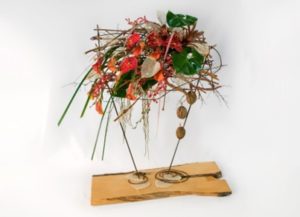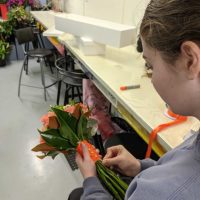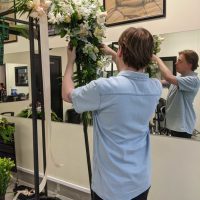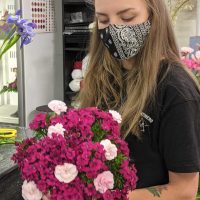ARE YOUR FLORISTRY SKILLS UP TO DATE?
It is an interesting question. For example, is spiralling better than cross stems in method? In the last ten years training has only supported spiral or straight stemmed construction. A florist trained earlier may not know how to spiral. Stems are neater especially in glass vases and by locking into the spiral as you construct breakage is minimal. There are always advantages for change in an industry and a smart employer should be open to change it they see advantages. Large hand tied sheaves have better dimension and neater stems if made on a spiral method. How many florists use this method of construction? I have had so many occasions where an employer has said to me, “Why are you teaching this method? That’s not the method I learnt when I was an apprentice/junior?” Well, methods change for a reason and if a florist is not up to date they will become behind in ideas, methods and tends.
Product use in floristry
Product availability presents a much larger and varied range to florists than ever before. Apack and Koch are large, proactive suppliers with a constant range of new products. Some products are not utilised by florists because the method of use is unknown to the florist or they resist change. Consider cold glue as one example. A wrist corsage can be made on a manoeuvred aluminium wire base structured to fit the wrist. Roll the wire into a circle at the centre of the wrist and glue (sparingly) two leaves, one opposite the other. Create a small fern base and from the centre apply glue and form the corsage by gluing flowers and your design placements. A florist who has never
seen or experimented will offer comments such as “You wouldn’t do that as the flowers fall off”, or
“That’s not the way I learnt.” The florist with an open mind will find speed of product increases, therefore profit increases and as you can use materials differently the product is exciting and individual. Also once the glue sets nothing will move. Test it to be sure!
Industry functions can be a way of observing change in techniques and these are promoted through industry associations. The Australian Association of Floral Designers offers workshops utilising new products and techniques to show florists their use and adaptability to their store. I have had many requests from florists to undertake a refresher course to explain modern work. All floristry is based in the use of the elements and principles but observing and listening to explanations greatly assists the knowledge. Some relay companies hold workshops but only to establish how to make their products to a desired visual presentation. You Tube (Videos), Facebook (like and follow businesses and individual designers), Instagram (same owners as facebook) and Pinterest (digital pin board to collaborate ideas) show the viewer actual construction or photos but be wary as some are non professional presentations and some methods may not be current practice.
A good Registered Training Organisation (R.T.O.) should be ahead or at least up to date with current industry practice. Remember, it is the employer that chooses the R.T.O. based on reputation and standards. Therefore, apprentices and trainees are shown new methods and ideas in floristry. Be wary of an RTO that trains and completes students with non industry experience. (Marjorie Milner College is an RTO (RTO Number 3930))
Pitfalls of inexperienced owners
A downfall in floristry is the number of businesses that change hands from a qualified owner to an owner who is totally new to floristry. The business is not driven by knowledge and staff hold the responsibility of success or failure of the business in their hands. This practice has definitely affected floristry standards. I have been advised that in some cases a florist business is seen as a cheap business to buy to obtain an entry visa into the country. Imagine the impact on the business and damage inflicted on standards of business practice. A good business is a team driven by the person with the most experience. When an owner has no knowledge of product or standards it is easy for standards to slip and who promotes new ideas of innovation? Lack of qualified florists has become a major problem within the industry.
The division in florists is widening. If the owner is not a florist the mentoring and control of standards suffers and this in turn places more pressure on the staff. The lack of professionalism reflects poorly on the buying public and this is a negative to our industry standards.
[/et_pb_text][et_pb_image _builder_version=”4.0.7″ src=”https://www.marjoriemilner.edu.au/wp-content/uploads/2020/01/MarjorieMilnerCollegeWristCorsageNov2015-300×168-1.jpg” hover_enabled=”0″][/et_pb_image][et_pb_text _builder_version=”4.0.7″ hover_enabled=”0″]Written By Gregory Milner, M.Ed
[/et_pb_text][/et_pb_column][et_pb_column type=”1_3″ _builder_version=”4.0.7″][et_pb_sidebar area=”sidebar-1″ _builder_version=”4.0.7″ global_module=”1039″ saved_tabs=”all”][/et_pb_sidebar][/et_pb_column][/et_pb_row][/et_pb_section]























